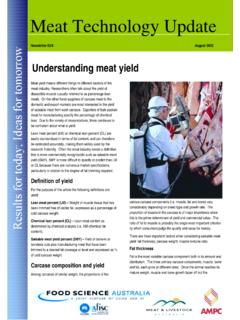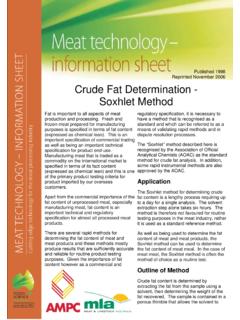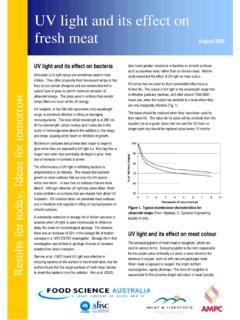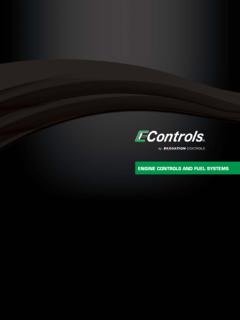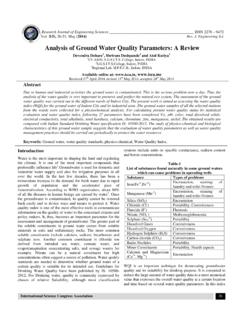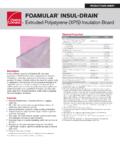Transcription of Meat technology update
1 In setting a shelf-life, both food safety and consumer acceptance must be considered. Food safety is always considered first when establishing use by dates, but consumer acceptance of sensory attributes often governs best-before dates. update 3/03, June 2003 discussed the situations where date labelling of meat products is required. This update considers approaches for shelf-life , food is considered to be past its shelf-life when it is no longer acceptable to the consumer. It could be that the colour, flavour, texture, aroma or nutrient content have deteriorated to the point where the food is no longer acceptable; or it could be when a food-safety issue arises where the food product may make consumers ill. Whilst shelf-life is usually equated with spoilage, for fresh meat in particular., the end of shelf-life might be reached before spoilage, as such, is evident. For example, the loss of bloom of mince or steaks, or reaching a microbial count specified as an acceptable maximum by a retailer, may be the determinant of retail shelf-life; whereas spoilage, as defined by off-odour and slime, would be the point at which it is unacceptable for Food Standards Code of Food Standards Australia New Zealand, FSANZ, includes a standard that prescribes a date-marking system for packaged food intended for retail sale or catering purposes.
2 Retailers usually print a use by date on steaks, roasts and other packaged fresh meats. Under normal circumstances of hygienic handling and storage at 4 C or colder, spoilage bacteria, rather than pathogens, grow on uncooked meat and meat products; and since these meats will be cooked by the consumer before they are consumed, these products could therefore have a best before date, rather than a use by one. On the other hand, for ready-to-eat (RTE) meat products, the shelf-life may be influenced by the growth of pathogens ( Listeria), even at the recommended storage temperature, and the date must be a use by one. The reason for spoilage may be different for uncooked products compared with RTE ones. This needs to be taken into account when deciding how to determine and validate a claimed shelf-life. Determining the shelf-life of an RTE meat product may well involve microbiological assessment including (probably) testing for Listeria monocytogenes.
3 Determining the shelf-life of T-bone steaks on the other hand, will probably be based on assessment of colour stability and maybe odour during retail and home storage, and perhaps accompanied by some microbiological testing against specifications set by must date-mark any pre-labelled packages of fresh or processed meat. In addition, meat processors are being asked by retailers to provide dates for larger packs of meat such as vacuum packs that will eventually be either sold intact or sliced and prepared as smaller retail packs. Here, shelf-life of the large pack should take into account that retailers will expect a display life of two, perhaps three, days from the retail packs prepared from it. Increasingly, meat processors are being asked to show that their claimed shelf-lives for products have been validated. This update discusses how the validation might be demonstrated. General approaches to shelf-life estimationThe term shelf-life is variously used for the: point of retail display at which consumers decline to purchase; or time to when the product no longer has an acceptable eating experience for the consumer; or time to when consumption is no longer shelf-life determination involves an experimental study of the deterioration of the food, culminating in identification of the point that marks the end of its shelf-life.
4 It is important that you are clear about the shelf life that you wish to are several established approaches for the gathering of shelf-life data on food products:Meat technology update2/06 April 2006 MEAT technology UPDATEC utting edge technology for the meat processing industryShelf-life testing: methods for determining the claimable life of meat products. estimating shelf-life based on published data; utilising known distribution times for similar products on the market; using consumer complaints as the basis for determining whether a problem is occurring; accelerated shelf-life testing; or assessing changes that occur in trial packs under simulated commercial little information on the shelf-life of specific products is published. Many shelf-life data are proprietary and, therefore, not available. Estimates from the published literature, some of which are summarised in Meat update information sheet Storage life of meat , September 2002, are rather old and may not relate closely enough to current processing and packaging systems, or to current retailer or consumer expectations.
5 The exception to this generalisation is that the food safety literature can often be used in circumstances where shelf-life is determined by an unacceptable safety risk. Neither the utilisation of known distribution times, nor the consumer complaint approach, can be validated satisfactorily; and accelerated testing has little application to meat products probably being limited to shelf-stable long-life products such as beef most direct and common way to determine shelf-life is to carry out storage trials under controlled conditions that reflect those that the meat normally encounters during the usual course of distribution, retail display, and storage by the consumer. Selection of an appropriate, reliable approach to simulating quality loss that will occur during commercial distribution and storage is an important first step when using this approach. Select conditions that you anticipate will cover most situations, but not necessarily conditions of significant abuse.
6 For example, if the package carries the statement keep refrigerated , it is unrealistic and inappropriate to undertake trials at 0 C. A more realistice temperature would be 4 C if a period of storage in the home is likely. Take into consideration the fact that both chilled and frozen meats will be subjected to temperature fluctuations, particularly during summer months. It is often advsable to determine the shelf-life at two temperatures the recommended storage temperature and the maximum temperature expected under normal transport and storage conditions. Of the categories of food spoilage that can occur physical, chemical, and microbiological the two principal spoilage mechanisms that affect shelf-life of meat are microbial growth and oxidation of myoglobin (browning) or lipids (rancidity).Estimating shelf-lifeBefore shelf-life testing can be carried out, it is important to establish which quality characteristics are important to the purchaser, or consumer, for the product under assessment.
7 This may vary between products. Establishing the criteria of importance and defining the acceptable standards are policy matters for manufacturers and retailers to resolve. As mentioned earlier, variable quality characteristics to consider include: safety; odour; meat colour; flavour; overall appearance; texture. Food safety shelf-life is limited by the presence of unacceptable numbers of pathogens on a meat or meat product, and is a function of the initial level of contamination by the pathogens in question, along with time and temperature. It is common, however, to regard food safety as being compromised if the food has been subjected to conditions that permit growth of pathogens if the pathogens happened to be present. Note that it is important not to rely on shelf-life evaluation to establish the microbiological safety of the product. In this respect, the question that needs to be addressed is: Will the product formulation and storage conditions control growth of pathogens during the designated shelf-life if they were present?
8 In this circumstance a HACCP analysis is necessary to identify which, if any, pathogens are relevant, and challenge testing may be required, particularly in the case of RTE meats. Such testing involves deliberate inoculation of the product with the pathogens that have been identified in HACCP, or with indicator bacteria that are known to behave similarly in the product to the uncooked meats, and mostly with RTE meats, it will not be the presence of pathogens that dictate of shelf-lifeIn fresh meats that are stored in air, pseudomonads will dominate the total population of bacteria, so a standard plate count is a good guide to the onset of vacuum-packed meat, however, total count is not a good index. As vacuum-packed meat is stored in the absence of oxygen, growth of pseudomonads, as strict aerobes, is restricted. Instead, after storage, the bacterial population will consist mainly of lactic acid acceptability of meat and meat products, particularly frozen ones, can be affected by factors that are not microbiological.
9 They include: meat colour and appearance; rancidity caused by chemical oxidation of fats at low temperature; changes in texture caused by extended enzymic activity or product drying during storage, freezer burn; texture, flavour and odour changes caused by other chemical reactions occurring in the product during storage toughening from protein denaturation or colour and flavour changes from non-enzymic browning of meat is due to oxidation of the meat pigment myoglobin. Low pH meat and lower seems to be more susceptible to colour deterioration. Development of browning can be followed instrumentally using a colour meter. If previous experience has told you what the causal products of odour and flavour spoilage are, they can be tested for using appropriate chemical analyses, gas chromatography combined with mass spectrophotometry. Instrumental techniques are only useful if there is a good knowledge of the relationship between the levels of specific chemicals and consumer perceptions of spoilage of your product.
10 If that knowledge is not available, information on the deterioration of quality has to be obtained by the use of taste panels using either trained technicians or untrained specific examplesRaw meats - freshPathogen growth is most conveniently estimated in raw meats by predictive microbiology using a model such as that developed in Australia by the University of Tasmania and Meat & Livestock Australia. PAGE 2 MEAT T EchnoloGy update APRIl 2006 The criteria specified in the Export Control (Meat and Meat Products) Orders 2005 are appropriate for determining what would be deemed unacceptable temperature abuse that would compromise fresh meats that are stored in air in over-wrapped trays, as the numbers of pseudomonad bacteria reach around 100 million per cm2, they produce a putrid odour and slime forms on the meat surface. The pseudomonads will dominate the total population of bacteria, so a total count is a good guide to the onset of microbial populations may not necessarily impair sensory characteristics, but a pre-determined level of micro-organisms, together with factors such as sensory attributes, is often used to indicate that the end of life has been reached.
